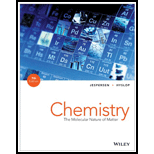
Interpretation:
The given compounds are to be identified as molecular or ionic, and their names are to be determined.
Concept Information:
A binary compound that is formed by the transfer of electrons between metals and non-metals is called an ionic compound.
If the two elements in a binary compound are non-metals, then it is a molecular compound.
For naming of ionic compounds containing polyatomic ions, the name of the metal (cation) or a polyatomic cation written first, followed by the name of anion, this can be non-metal, and it this is non-metal (anion), change the suffix of non-metal to
In case of the stock method of naming of compound, the oxidation states of some or all of the elements in a compound are indicated in parentheses by Roman numerals
Rules of naming molecular compounds:
Replace the ending of the second element with “ide”.
While naming molecular compounds prefixes are used to indicate the number of a given element present in the compound like ” mono-” indicates one, “di-” indicates two, “tri-” is three, “tetra-” is four, “penta-” is five, and “hexa-” is six, “hepta-” is seven, “octo-” is eight, “nona-” is nine, and “deca” is ten.
In case there are two vowels in a row that sound the same once the prefix is added, the extra vowel on the end of the prefix is removed. For example, one oxygen would be monooxide, but instead it’s monoxide. The extra o is dropped.
In case of the compound having only one of the first element, prefix can be dropped. For example, CO is carbon monoxide, not monocarbon monoxide.
The more electropositive atom is written first, followed by the more electronegative atom with an appropriate suffix. For example, H2O (water) can be called dihydrogen monoxide (though it’s not usually).
Want to see the full answer?
Check out a sample textbook solution
Chapter 2 Solutions
Chemistry: The Molecular Nature of Matter
- (a) List four physical characteristics of a solid metal. (b) List two chemical characteristics of a metallic element.arrow_forwardWhat is the molar mass of the sodium alum salt, KAl(SO4)2 •12H2O?arrow_forwardAlthough not a transition metal, lead can form Pb21 and Pb41 ions. Write the formula for the compound formed between each of these lead ions and the following anion: (a) Oxide ionarrow_forward
- Which of these elements is most likely to form ions with a2+charge?(a) Li (b) Ca (c) O (d) P (e) Clarrow_forwardCr(s) + O2(g)→ Cr,O3(s)arrow_forwardA 3.00- g sample of an alloy of Pb Lead was dissolved in nitric acid (HNO3). Sulfuric acid was added to this solution, which precipitated 1.69 g of lead sulfate (PbSO4). What is the percentage of lead (Pb) in the sample? (Given the atomic mass of Pb = 207 , S =32, O = 16 )arrow_forward
- 2.43 g magnesium was completely burnt in oxygen to give magnesium oxide. 2 Mg(s) + O2(g) → 2 MgO(s) (Relative atomic masses: O = 16.0, Mg = 24.3) (a) Draw the electronic diagrams of O2 and MgO, showing electrons in the outermost shell only. (b) (i) How many mole of magnesium was present? (ii) How many mole of oxygen was required to completely react with the amount of magnesium in (i)? (iii) Hence, calculate the amount of oxygen required to completely react with the magnesium. (c) Similarly, calculate the amount of MgO formed.arrow_forwardWrite a balanced equation for the following by inserting the correct coefficients (if a coefficient = 1, enter "1" in the provided box). Ca3(PO2() + SiO:() +C) – C(s) → CaSiO3(1) + || CO(g) + +P.()arrow_forwardWhat is the mass percent of aluminum in Al(NO3)3 • 9H2O?arrow_forward
- Write formulas for the compounds:(i) iodic acidarrow_forwardThe oxides of nitrogen are very important components inurban air pollution. Name each of the following compounds:(a) N2O, (b) NO, (c) NO2, (d) N2O5, (e) N2O4.arrow_forwardA 67.2 g sample of gold and palladium allo contains 3.40x10^23 atoms. What is the mass percentage of the gold in the alloy. And what is the mass percentage of the palladium in the alloy? Do not give handwriting solution.arrow_forward
 Introduction to General, Organic and BiochemistryChemistryISBN:9781285869759Author:Frederick A. Bettelheim, William H. Brown, Mary K. Campbell, Shawn O. Farrell, Omar TorresPublisher:Cengage Learning
Introduction to General, Organic and BiochemistryChemistryISBN:9781285869759Author:Frederick A. Bettelheim, William H. Brown, Mary K. Campbell, Shawn O. Farrell, Omar TorresPublisher:Cengage Learning Chemistry: Principles and ReactionsChemistryISBN:9781305079373Author:William L. Masterton, Cecile N. HurleyPublisher:Cengage Learning
Chemistry: Principles and ReactionsChemistryISBN:9781305079373Author:William L. Masterton, Cecile N. HurleyPublisher:Cengage Learning Chemistry & Chemical ReactivityChemistryISBN:9781337399074Author:John C. Kotz, Paul M. Treichel, John Townsend, David TreichelPublisher:Cengage Learning
Chemistry & Chemical ReactivityChemistryISBN:9781337399074Author:John C. Kotz, Paul M. Treichel, John Townsend, David TreichelPublisher:Cengage Learning Chemistry & Chemical ReactivityChemistryISBN:9781133949640Author:John C. Kotz, Paul M. Treichel, John Townsend, David TreichelPublisher:Cengage Learning
Chemistry & Chemical ReactivityChemistryISBN:9781133949640Author:John C. Kotz, Paul M. Treichel, John Townsend, David TreichelPublisher:Cengage Learning Organic ChemistryChemistryISBN:9781305580350Author:William H. Brown, Brent L. Iverson, Eric Anslyn, Christopher S. FootePublisher:Cengage Learning
Organic ChemistryChemistryISBN:9781305580350Author:William H. Brown, Brent L. Iverson, Eric Anslyn, Christopher S. FootePublisher:Cengage Learning




